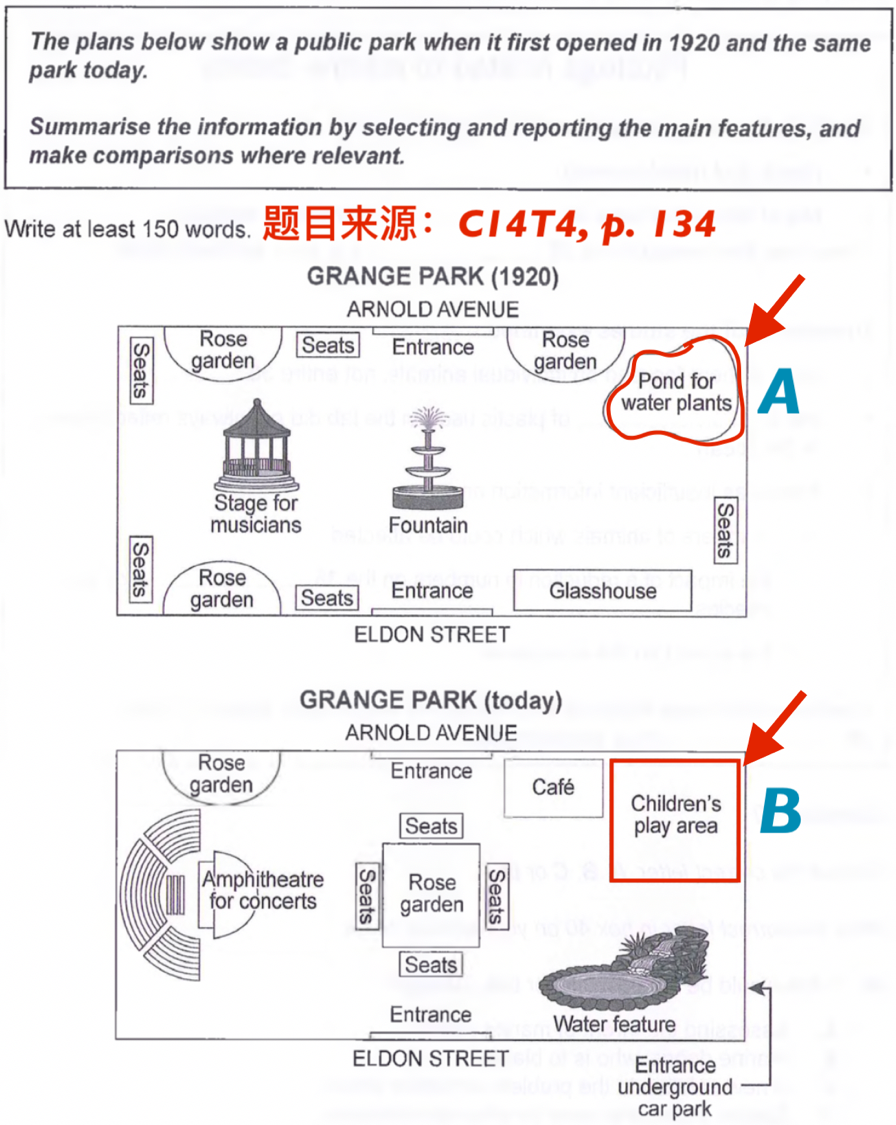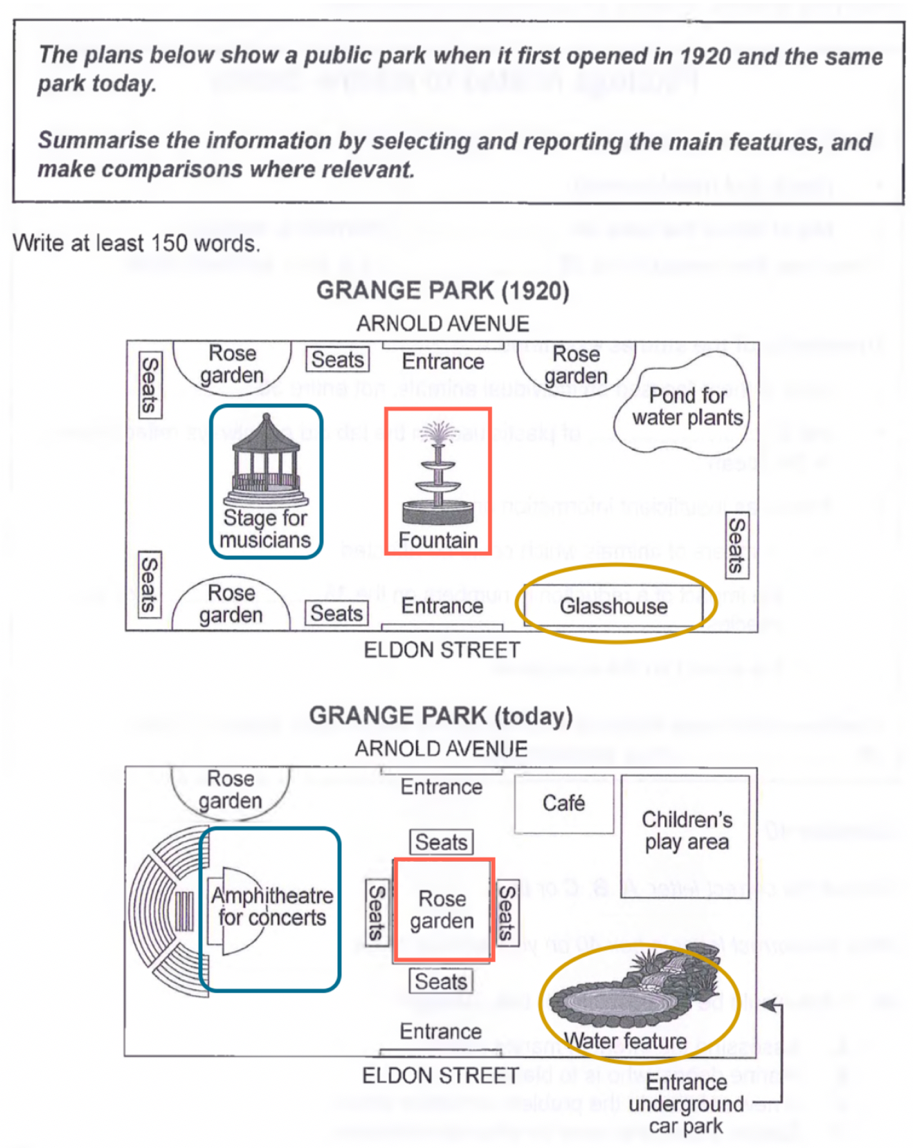
对于非数据类图表小作文的考核,地图题的考频一般会比流程图要高,且绝大多数地图题都属于“动态变迁类”的题;而“直接取代”类表述,又是“动态变迁类”地图中80-100%会有的考点。所以希望考生们能够引起重视。
说起“直接取代”,学生在表述过程中,通常会使用到 ‘be replaced by/be substituted by/take the place of’ 来表述。replace这个词在柯林斯词典中的解释是这样的:
‘If one thing or person replaces another, the first is used or acts instead of the second.’
也就是说,原有事物A被弃用掉了,在雅思地图题中会体现为原有事物不见了,没有了,消失了。一个全新的事物B替代了它,并被投入到使用中。
很多学生在表述中多半选用的是直译的方法。这个当然是没问题的,也确实是可以使用A be replaced/substituted by B之类的表述,考官在范文中也用到了,比如:
The bandstand (stage for musicians) has also been replaced, by an amphitheatre for concerts and associated seating.
--- from C14T4, p. 134
可是,咱们只能选择直译“取代”之意,使用以上这些表述麽,当然不是!只要理解了“直接替代”的真正含义,我们就可以写出“花式取代”:
· 原来的事物没有了,在原有事物所处的位置上,增添了新事物;
· 新事物位于原有事物所处的位置上(静态表述);
· 新事物被建在了原有事物所处的位置上(动态表述)。
通过这些理解,我们其实本质上可以结合“拆除”和“新建”这两类表述去描写“取代”。在这里,我以剑桥真题第14册94页的一道题为例,来尝试通过不同的句式表述“原有的Pond for water plants被现在的Children’s play area所取代”这一特征:

定义一 原来的事物没有了,在原有事物所处的位置上,增添了新事物。
① 该句式and后半部分使用了方位介词位于句首的方式
A has gone1 and in its place2 is B.
1: has been removed / has been demolished / has been knocked down / has been torn down
2: location / site / area
最后我们可以对该特征做如下表述:
- The pond for water plants has gone and in its place is a children’s play area.
定义二 新事物位于原有事物所处的位置上
① 这里我们可以主要用到there be句型来表述事物静止存在的状态:
There is now B3 at the original4 place of A.
3: Now B lies; B is now sited / located / situated
4: previous / former
A newly-built B occupies5 the original place of A.
5: take up
② 在此基础上,可以引入现在分词做伴随状语的概念:
There is now B, occupying the original place of A.
③ 还可以使用where引导的定语从句对先行词place做修饰:
There is now B at the place where A stood6.
6: A lay (* 原形是lie喔~) / A was once sited / A was once located / A was once situated
④ 进而可以结合“现在分词做伴随状语”和“定语从句”这两个语法点:
There is now B, occupying the place where A stood.
⑤ 或者可以用到where引导地点状语从句的方式:
There is now B where A stood.(不常用)
⑥ 不过更常用的语序如下:
Where A stood, there is now B.(常用)
最后我们可以对该特征做如下表述:
- There is now a children’s play area at the original place of the pond for water plants.
- A newly-built children’s play area occupies the original place of the pond for water plants.
- There is now a children’s play area, occupying the original place of the pond for water plants.
- There is now a children’s play area at the place where the pond for water plants stood.
- There is now a children’s play area, occupying the place where the pond for water plants stood.
- Where the pond for water plants stood, there is now a children’s play area.
定义三 新事物被建在了原有事物所处的位置上
我们其实还可以从新事物被修建的动态角度去表述,同样可以运用到上述的“现在分词做伴随状语”、“定语从句”和“地点状语从句”等语法点。
① B has been built7 at the original place of A.
7: has been constructed / has been added
② B has been built, occupying the original place of A.
③ B has been built at the place where A stood.
④ B has been built, occupying the place where A stood.
⑤ B has been built where A stood.(不常用)
⑥ Where A stood, B has been built.(常用)
最后我们可以对该特征做如下表述:
- A children’s play area has been built at the original place of the pond for water plants.
- A children’s play area has been built, occupying the original place of the pond for water plants.
- A children’s play area has been built at the place where the pond for water plants stood.
- A children’s play area has been built, occupying the place where the pond for water plants stood.
- Where the pond for water plants stood, a children’s play area has been built.
最后,在剑14这道动态变迁地图题中,另外还有几个关于“直接取代”的特征,亲爱的读者在掌握了以上这些技巧后,可以思考如何表述这一特征啦。

备注 :
· A指代原有事物(旧事物),B指代新事物;
· 标红的地方代表可以替换为其它同类表述;
· 框出来的地方是语法点。
参考资料:
剑桥真题14